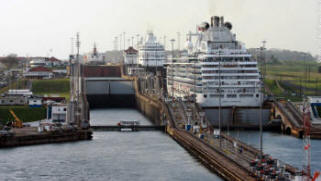|
For years, most cruise ships could pass
through the locks, but as they got increasingly bigger over time, they outgrew
the canal. Now the canal is expanding with a third lane of larger locks and will
be able to accept many bigger cruise ships in the near future.
 The
term "Panamax" refers to ships of proper size that will fit through the existing
locks, 1,050 by 110 feet in outer dimensions. And there are many classes of
cruise ship that are designed to those transit specifications such as Celebrity
Cruises’ Millennium-class, Princess Cruises’ Coral-class and Holland America
Line’s Vista- and Signature-class. The
term "Panamax" refers to ships of proper size that will fit through the existing
locks, 1,050 by 110 feet in outer dimensions. And there are many classes of
cruise ship that are designed to those transit specifications such as Celebrity
Cruises’ Millennium-class, Princess Cruises’ Coral-class and Holland America
Line’s Vista- and Signature-class.
However, most ships built thereafter have
exceeded the limits of the Panama Canal, especially Royal Caribbean
International’s Oasis-class and its Allure of the Seas, currently the largest
cruise ship in the world until it’s superseded by the Harmony of the Seas in
2016.
At a time when Nicaragua is exploring options for its own canal project, the
Panama Canal is expanding to accommodate larger vessels, supertankers in
particular, which account for far more traffic and income for the canal zone
than occasional cruise ships do. Nonetheless, the expansion will positively
affect the cruise industry, opening up greater itinerary opportunities for
bigger ships. Of course, larger cruise ships can already overcome size
restrictions with longer routes, as many have, but a direct cut through the
Americas will greatly simplify future repositionings.
So once completed, will the Harmony of the Seas be able to fit through? Well,
not quite.
The new lane of locks, under construction in
parallel with the existing ones, will measure in at 1,400 by 180 feet with a
60-foot draft, but the maximum allowed ship size will be capped to 1,200 by 161
feet and a 50 foot draft.
The Oasis class, which will include the slightly larger Harmony of the Seas,
indeed fits within the lock dimensions. However, the ships’ 236-foot height
above the water line will not clear the Bridge of the Americas, which spans the
Pacific Ocean entrance of the canal with a height of 201 feet below. So unless
the bridge, which was built in 1962, is either removed or replaced by a taller
one, the Harmony of the Seas is out of luck.
Next up in decreasing size is another Royal Caribbean International class of
cruise ships, the 168,666-ton Quantum class consisting of the line’s newest
Quantum of the Seas, Anthem of the Seas and Ovation of the Seas coming in April
2016. They would clear the edges, and while their exact height is not disclosed,
considering their 18 decks at an average of 10 feet each, they would measure in
at 180 feet overall off the waterline, which would clear the bridge.
This is good, since these ships were designed as all-weather ones that would
work well in Alaska, and as five are currently scheduled, they would be perfect
for easily repositioning from the Caribbean to Alaska.
But that formula for calculating the exact height of ships doesn’t always work,
as Royal Caribbean International’s even smaller 18-deck-tall Freedom-class ships
are 209 feet in height, putting them outside the bridge clearance. Even Cunard's
Queen Mary 2, designed to clear the 228-foot height of the Verrazano-Narrows
Bridge in New York won’t clear Panama’s span, unfortunately.
With certainty, at least given what we know of their height and if the ships’
overhanging lifeboats don’t get in the way, it’s known that Norwegian Cruise
Line’s Breakaway-class, the Norwegian Breakaway and Norwegian Getaway, up there
with the largest ships in the world, would clear a full Panama Canal transit.
Actual passage through the expansion is, of course, subject to its completion,
and the Panama Canal project has already been delayed. It was once scheduled for
completion for the facility’s 100th anniversary on August 2014, but strikes and
disputes pushed that date back to 2015 and now to April 1, 2016. Time will tell
when the new Panama Canal officially opens, which cruise ships will be able to
successfully pass through it and whether or not that pesky bridge clearance will
ever be overcome. |


